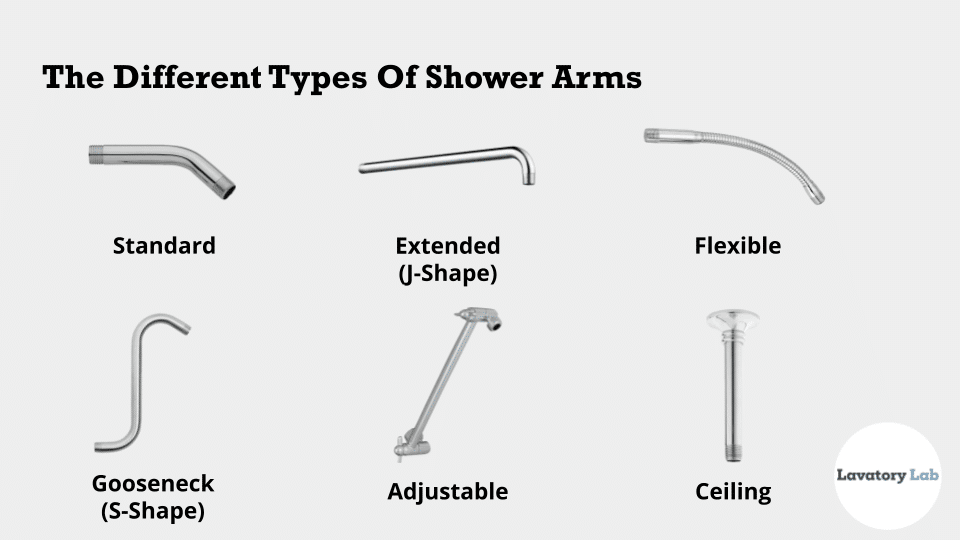A shower arm is a short pipe, typically .5” in diameter, that connects between the showerhead and the water line behind the wall.
Shower arms may require replacement for several reasons, including installing a new showerhead, showing signs of rust and corrosion, or simply due to the person’s height or people who plan on using the shower stall.
Below we’ll share a few other important details about shower arms that you’ll find helpful.
Shower Arm Types
As you can see in the picture below, shower arms come in a variety of shapes.

Here’s how each of the shower arm types differs from one another:
- Standard: This is the most common type of shower arm. It connects the showerhead to the water pipe behind the wall. Suitable for everyday use and normal-sized showerheads.
- Extended (J-Shape): Averaging 16” in length, this extended shower arm is used for rainfall showerheads. It moves the water away from the wall to prevent puddling and gives you more room to clean.
- Flexible: The flexible shower arm is ideal for families of varying heights or in shared bathroom settings. You can quickly raise or lower the showerhead so you can bathe comfortably.
- Gooseneck (S-Shape): This shower arm helps raise the showerhead so taller individuals can bathe more comfortably. It’s also a great solution if the shower arm access point was too low when initially set.
- Adjustable: This is a classier take on the flexible shower arm. This design is suitable for home use where heights vary significantly. Here we review a few adjustable shower arms.
- Ceiling: Coming straight from the ceiling, this mount is typically used for rainfall showerheads. Learn more about some of the pros and cons in this article.
3 Installation Tips
Installation for most shower arms is straightforward. There are plenty of great tutorials available on YouTube. Here are a few that demonstrate the process clearly and easily: video 1, video 2.
When changing a shower arm, have the following tools available:
- Channel Locks or Wrench: This helps grip the shower arm to tighten or loosen the fixture. Ensure that you use a thick rag or cloth when gripping the shower arm, so you don’t scratch or ruin the exterior.
- Teflon Tape: Also known as polytetrafluoroethylene (PTFE), Teflon Tape seals the threads to prevent water leaks at each end of the shower arm.
- Screwdriver (Optional): By placing it into the shower arm once the showerhead has been removed, a screwdriver will help to provide additional leverage, making the removal and installation job easier.
Accessories
Here are a few small pieces of hardware that may be attached to the shower arm:
- Flange: This is included with nearly all new shower arms. It prevents water from seeping back into the pipe and provides a more elegant appearance once the job is completed. This is mounted to the wall typically with caulk or plumbers putty.
- Diverter: A diverter is added to the shower arm to switch the flow of water between two showerheads.
- Mount: Handheld showerheads come with a mount so you can rest it on the shower arm when not in use.
Threading
All shower arms adhere to the 1/2″ NPT (national pipe thread) standard size. This means that you can safely purchase any shower arm whether it be online or in-store without having to worry about whether it will fit or not. NPT is a U.S. standard for tapered threads used on pipes and fittings. When researching other countries, many will have their own standards (ex: British Standard Pipe), but still measure to 1/2″.
Finish
Like all bathroom fixtures, including towel warmers and even shower panels, there are several finishings to choose from, including brushed nickel, stainless steel, chrome, and more. When selecting a shower arm finish, be sure to match it with the same finish as your showerhead.
Length
When deciding on the proper length of shower arm for your bathroom, there are a few factors you will need to take into account. The first is the type of shower arm you are planning to install.
If you are installing a standard or adjustable shower arm, then it doesn’t need to extend more than 6″ as the shower head will be pointed towards the person.
However, if you are installing an extended shower arm for a rainfall shower head, then you will need one that extends at least 18″ to 24″ so the shower head will be positioned far enough from the wall so you can bathe comfortably. Ideally, the shower arm should extend far enough so it is centrally located over the drain in your shower.
Price
Shower arms range anywhere from $15 to $200. Like much of the hardware in the bathroom, price is impacted by craftsmanship, brand, country of origin, and the raw material used to make the hardware.
A Quick Note on Shower Columns
Shower columns and shower arms are two different types of bathroom fixtures. Shower arms are an extension from the water pipe behind the wall to a showerhead. Shower columns are one pipe containing a showerhead, wand, and, in some cases, an adjustment lever.
Conclusion
We hope that this article helped you learn more about shower arms and some of the different types available.
